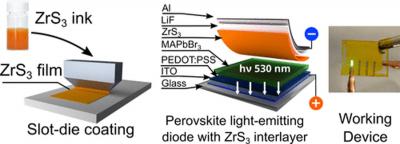A team of scientists from the NUST MISIS Laboratory of Advanced Solar Energy has proposed a new approach that uses the two-dimensional inorganic material zirconium trisulfide as the electron transport layer of a perovskite LED. In the future, this may allow the mass production of a new type of light-emitting diodes, as well as solving the problem of LED displays degradation, for example, in smartphones and TVs.

The screens of many modern smartphones and TVs "suffer" from pixel burnout. Due to the presence of an organic component in OLED-type matrices (and their derivatives), pixels begin to degrade when the same icons on the screen are lit for a long time. So far, manufacturers advise users to periodically change the screen interface, rearrange the icons in places and regularly update the screen saver. In fact, the problem could be solved by minimizing the use of organic components in the screen matrix. Perovskite diodes are proposed as a way to make a revolution in designing screens.
"At a certain stage of the research, the question inevitably arises: is the development suitable for implementation in mass production? The world experience in the assembly of perovskite LEDs is reduced to the layer-by-layer assembly of components by applying precursors to a rotating glass substrate. This allows us to achieve homogeneity of the layers, but it is completely unsuitable for mass production ' this approach does not presuppose the simultaneous loading of several samples," said one of the authors of the study, a research associate at the NUST MISIS Laboratory of Advanced Solar Energy Arthur Ishteev. "Therefore, we are interested in finding materials that would allow us to scale the production of perovskite LEDs."
The scientists are working on the adaptation of perovskite application technology by analogy with the industrial methods of the semiconductor industry. This will eliminate the disadvantages of fading blue organic LEDs in modern displays by replacing them with stable perovskite diodes.

